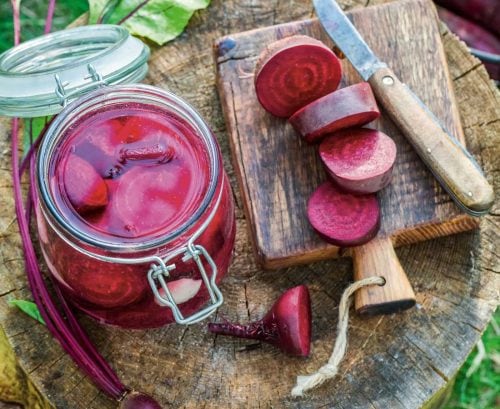
There are many good reasons to include beetroot in your diet, according to dietitian Jennifer Low.
The purple colouring comes from betalains, which act as antioxidants and may be anti-inflammatory. A wealth of other antioxidants, such as vitamin C, carotenoids and flavonoids can be beneficial.
They’re also a source of nitrate, which increases nitric oxide in the body, and this can help prevent arteries narrowing.
Pickling vegetables preserves them, and the nutrition remains the same – assuming you hadn’t left them to wither at the bottom of your veg drawer for ages before pickling!
Despite tasting saltier, when beetroots are pickled in vinegar, they contain barely any more sodium than fresh, so they’re just as healthy.
Growing your own beetroot to pickle
Let’s face it, however carefully you plan and plant your garden produce, it’s inevitable that you’ll end up with a glut of something. This presents a great opportunity to try pickling.
I love spending winter days preserving vegetables in my kitchen, knowing I can enjoy them over the coming months.
My garden is home to a rainbow-coloured collection of beetroot, from the common red to the more unusual golden varieties.
This year, I’ve ended up with an abundance, which suits me fine as I love eating beetroot all year round, whether it’s freshly sliced in summer salads or plucked from a jar and tossed into winter ones.
Which vinegar is good for pickling beetroot?
I like to separate the colours when I pickle beetroots so they don’t bleed into each other, but if you want to chuck them in the same jar, go for it – it won’t affect the taste.
I also select vinegars to match their subject: red wine vinegar for red beetroots and cider vinegar for the golden ones. Again, this penchant for colour ordering is a personal choice, so feel free to experiment.
What is important, however, is that you buy a good vinegar with at least 6% acidity. This is to ensure both quality of taste and pickling power. Remember, you can use the vinegar in your salad dressings, too.
What herbs and spices are good for pickling?
Popular extras to add to the pickling jar include slices of white onion, peppercorns and bay leaves.
What’s great about this is that over time you can adapt your recipe to flavours you love and create things that are unique to you.
Personally, I like to leave mine plain. This provides me with a blank culinary canvas, which means I’m free to add anything extra to the salad on the day, depending on my mood.
How to pickle
It requires minimal effort: just the two ingredients and a large sterile jar. Before you get started, sterilise your jar. The traditional method is to wash it thoroughly in very hot soapy water, then rinse in hot water and put in a low oven to dry out (about 10 min).
I prefer to take an even easier option – putting it on a very hot run in the dishwasher. If you’re planning on gifting your pickled goods, there are many beautiful jars available. I’m a fan of the kilner-style ones, which you can buy cheaply at Ikea – I’ve collected a few over the years.
1 Wear plastic gloves (unless you want stained hands) to remove the tops of the freshly picked beetroots, taking care not to damage the flesh or skin.
2 Divide your beets by colour and cook them in separate pans (if you don’t want them bleeding into each other) in boiling water – 15–30 min should do it, but it depends on their size. Drain and peel, wearing your plastic gloves. It’s a good idea to peel the lighter beetroots first to keep them pale.
3 Slice the beetroot and put it in the jar, leaving enough space at the top for the vinegar to fully cover it.
4 Bring the vinegar to the boil (in separate pans if you’re pickling different types) before carefully pouring it over the beetroot (use oven gloves to protect your hands).
5 Leave the pickles for at least two weeks before eating. Once opened, keep them in the fridge and eat within a month. They’ll keep unopened for several months.
For more articles like this see the health benefits of onions and coffee.
www.healthyfood.com










